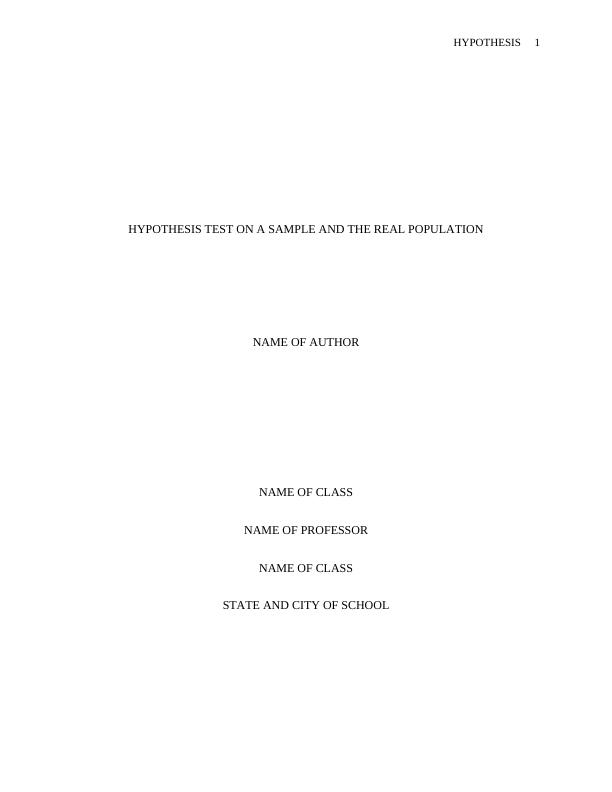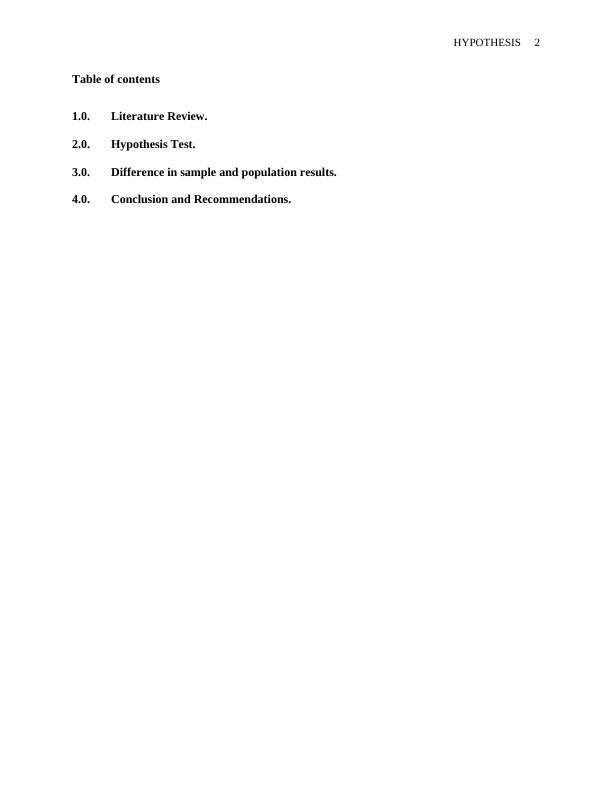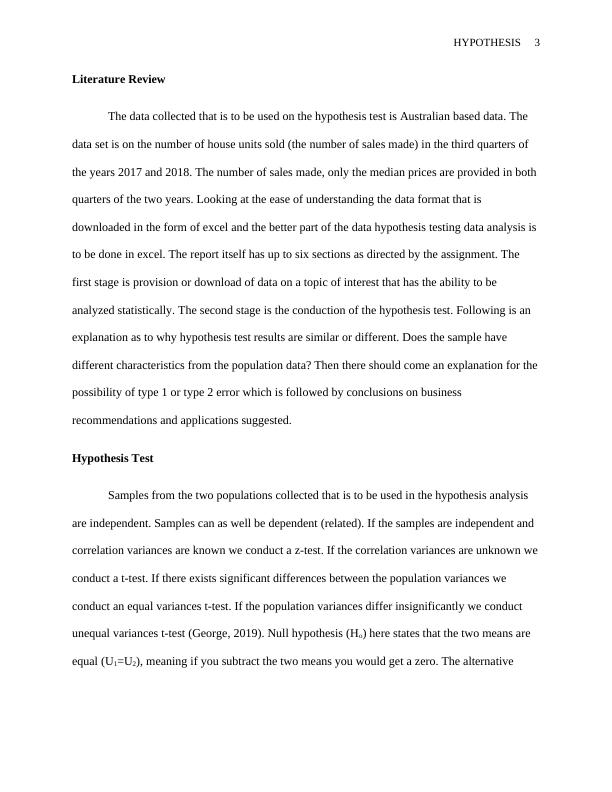Hypothesis Test on a Sample and the Real Population
Added on 2023-04-20
12 Pages1753 Words379 Views
HYPOTHESIS 1
HYPOTHESIS TEST ON A SAMPLE AND THE REAL POPULATION
NAME OF AUTHOR
NAME OF CLASS
NAME OF PROFESSOR
NAME OF CLASS
STATE AND CITY OF SCHOOL
HYPOTHESIS TEST ON A SAMPLE AND THE REAL POPULATION
NAME OF AUTHOR
NAME OF CLASS
NAME OF PROFESSOR
NAME OF CLASS
STATE AND CITY OF SCHOOL

HYPOTHESIS 2
Table of contents
1.0. Literature Review.
2.0. Hypothesis Test.
3.0. Difference in sample and population results.
4.0. Conclusion and Recommendations.
Table of contents
1.0. Literature Review.
2.0. Hypothesis Test.
3.0. Difference in sample and population results.
4.0. Conclusion and Recommendations.

HYPOTHESIS 3
Literature Review
The data collected that is to be used on the hypothesis test is Australian based data. The
data set is on the number of house units sold (the number of sales made) in the third quarters of
the years 2017 and 2018. The number of sales made, only the median prices are provided in both
quarters of the two years. Looking at the ease of understanding the data format that is
downloaded in the form of excel and the better part of the data hypothesis testing data analysis is
to be done in excel. The report itself has up to six sections as directed by the assignment. The
first stage is provision or download of data on a topic of interest that has the ability to be
analyzed statistically. The second stage is the conduction of the hypothesis test. Following is an
explanation as to why hypothesis test results are similar or different. Does the sample have
different characteristics from the population data? Then there should come an explanation for the
possibility of type 1 or type 2 error which is followed by conclusions on business
recommendations and applications suggested.
Hypothesis Test
Samples from the two populations collected that is to be used in the hypothesis analysis
are independent. Samples can as well be dependent (related). If the samples are independent and
correlation variances are known we conduct a z-test. If the correlation variances are unknown we
conduct a t-test. If there exists significant differences between the population variances we
conduct an equal variances t-test. If the population variances differ insignificantly we conduct
unequal variances t-test (George, 2019). Null hypothesis (Ho) here states that the two means are
equal (U1=U2), meaning if you subtract the two means you would get a zero. The alternative
Literature Review
The data collected that is to be used on the hypothesis test is Australian based data. The
data set is on the number of house units sold (the number of sales made) in the third quarters of
the years 2017 and 2018. The number of sales made, only the median prices are provided in both
quarters of the two years. Looking at the ease of understanding the data format that is
downloaded in the form of excel and the better part of the data hypothesis testing data analysis is
to be done in excel. The report itself has up to six sections as directed by the assignment. The
first stage is provision or download of data on a topic of interest that has the ability to be
analyzed statistically. The second stage is the conduction of the hypothesis test. Following is an
explanation as to why hypothesis test results are similar or different. Does the sample have
different characteristics from the population data? Then there should come an explanation for the
possibility of type 1 or type 2 error which is followed by conclusions on business
recommendations and applications suggested.
Hypothesis Test
Samples from the two populations collected that is to be used in the hypothesis analysis
are independent. Samples can as well be dependent (related). If the samples are independent and
correlation variances are known we conduct a z-test. If the correlation variances are unknown we
conduct a t-test. If there exists significant differences between the population variances we
conduct an equal variances t-test. If the population variances differ insignificantly we conduct
unequal variances t-test (George, 2019). Null hypothesis (Ho) here states that the two means are
equal (U1=U2), meaning if you subtract the two means you would get a zero. The alternative

HYPOTHESIS 4
hypothesis (H1) on the other states the two means are not equal (Alcaraz, Cantú and Torres,
2019).
For the dependent samples, we conduct paired t-test. For 1-tail test the hypothesis will
be; Ho; U1-U2=0 and H1=U1-U2<0 for a left tail test and it will be Ho; U1</=U2 and H1; U1-
U2>0 for a right tail test.
The main ideas behind the hypothesis test using the set of data that I have acquired is;
testing if the third quarter of 2017 recorded the highest median sales than quarter three of 2018.
The data had missing values in excel and this translates to the data set being dirty. This then
required the cleaning of the data set. The cleaning was done in R software (Kharel etal. 2019).
Then later exportation of the cleaned data was done from R to excel (Anderson, Spybrook and
Maynard, 2019).
The two variables to be used for hypothesis testing are independent. The population
standards derivatives of the variances are not known. This means that an independent t-test is
appropriate. Let U17 represent the mean for 2017 medians and let U18 represent 2018 medians.
Then the alternative hypothesis would translate to U17>U18, meaning U17-U18>0 and the alternative
hypothesis would translate to U17-U18</=0. Samples are independent and the actual variances
are unknown, so we will neither use t-test paired sample for means nor will we use z-test two
samples for a mean. For us to decide on whether we will be using t-test: two-sample assuming
equal variances or t-test: two sample assuming unequal variances, we will conduct an F-test for
two sample variances. The said results of the F-test give us the table below;
hypothesis (H1) on the other states the two means are not equal (Alcaraz, Cantú and Torres,
2019).
For the dependent samples, we conduct paired t-test. For 1-tail test the hypothesis will
be; Ho; U1-U2=0 and H1=U1-U2<0 for a left tail test and it will be Ho; U1</=U2 and H1; U1-
U2>0 for a right tail test.
The main ideas behind the hypothesis test using the set of data that I have acquired is;
testing if the third quarter of 2017 recorded the highest median sales than quarter three of 2018.
The data had missing values in excel and this translates to the data set being dirty. This then
required the cleaning of the data set. The cleaning was done in R software (Kharel etal. 2019).
Then later exportation of the cleaned data was done from R to excel (Anderson, Spybrook and
Maynard, 2019).
The two variables to be used for hypothesis testing are independent. The population
standards derivatives of the variances are not known. This means that an independent t-test is
appropriate. Let U17 represent the mean for 2017 medians and let U18 represent 2018 medians.
Then the alternative hypothesis would translate to U17>U18, meaning U17-U18>0 and the alternative
hypothesis would translate to U17-U18</=0. Samples are independent and the actual variances
are unknown, so we will neither use t-test paired sample for means nor will we use z-test two
samples for a mean. For us to decide on whether we will be using t-test: two-sample assuming
equal variances or t-test: two sample assuming unequal variances, we will conduct an F-test for
two sample variances. The said results of the F-test give us the table below;

End of preview
Want to access all the pages? Upload your documents or become a member.
Related Documents
Business Research Modulelg...
|10
|2139
|50
Statistics: Analysis and Resultslg...
|6
|725
|66
Biostatistics Assignment 1lg...
|5
|1172
|298
Mean and standard deviationlg...
|8
|1007
|24
Class Bin Frequency And Speed Testlg...
|6
|246
|16
Test for Difference in Variability in Waiting Times in Bank 1 and Bank 2lg...
|5
|708
|36